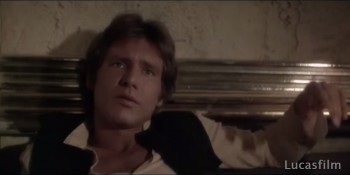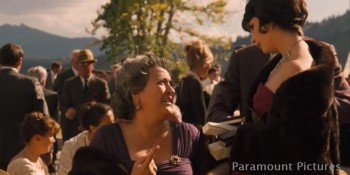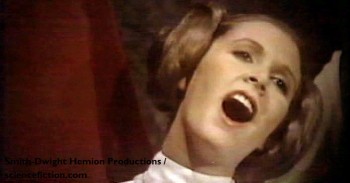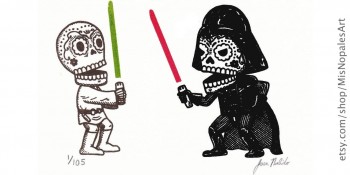Your regular Nerd/Wise contributor and my esteemed colleague, Kevin Hillman, made a very strong argument for the value of the Star Wars prequel trilogy . As a lifelong Star Wars fan, I largely agree with him. There are a lot of fun and exciting things in the prequels.
. As a lifelong Star Wars fan, I largely agree with him. There are a lot of fun and exciting things in the prequels.
If there ever was a series that has attracted more outrageous and unfair criticism than Episodes I to III, I surely haven’t heard of it. Kevin calls out the most fallacious and unsustainable criticisms directed at the films and, one by one, knocks them down with reasonable arguments. I see no reason to engage in a point-by-point rebuttal.
Because Kevin is missing the forest for the trees.
I disagree with the basic premise that Kevin is trying to argue, namely that the prequel trilogy is good in some objective sense, and therefore is of the same quality as the original trilogy . Art — whether cinema, television, literature, poetry, painting, sculpture — can by its very nature only ever be experienced subjectively. Nonetheless, there is an element of objectivity to good film-making. Indeed, there are basic tools that can objectively improve the structure of a work, thereby increasing its subjective appeal.
. Art — whether cinema, television, literature, poetry, painting, sculpture — can by its very nature only ever be experienced subjectively. Nonetheless, there is an element of objectivity to good film-making. Indeed, there are basic tools that can objectively improve the structure of a work, thereby increasing its subjective appeal.
That’s where George Lucas dropped the ball with the prequels.
I see four major, overarching issues with Episodes I to III: a lack of editing, an abundance of sub-par humor that doesn’t serve the story, a lack of continuity between the films, and the squandering of cultural capital earned among fans of the original Star Wars trilogy. It’s hard to keep these areas entirely separate, so expect things to get a little blurry around the edges at times.
Let’s start with what I feel is the biggest issue: Lucas chose to squander the overwhelming good will he had with Star Wars fans by making pointless and frustrating edits to the original trilogy. In 1997, the Star Wars Trilogy Special Edition was released upon the fan base, followed immediately by much gnashing of teeth. It was full of edits and CGI additions, all of which felt forced and unnecessary.
I’ll pluck the low-hanging fruit first. The infamous “Han shoots second” edit reduced Han Solo from a cunning, dangerous, and lightning-quick gunslinger to a man who got lucky. Never mind that the edit is awkward and obvious: it was a bad storytelling decision.
Though none of the other edits are as egregious, the CGI additions just don’t fit. They lack the solid, grounded feel of the practical special effects, model work, and puppetry of the trilogy as it was originally designed. And some of the new scenes are just pointless. Did we really need an extended musical performance in Jabba’s Palace? Did we really need any more dewbacks in Mos Eisley?
Fans, by and large, didn’t think so. And then Lucas added insult to injury by making it so that the original, unedited Episodes IV to VI would never be available again. If you wanted the original trilogy, you had to settle for Han shooting second. The fan base feared that this was a sign of things to come.
Now, to be fair, Industrial Light & Magic and Lucasfilm have always been innovators in the special effects world. A lot of what they were doing with digital sound, green-screen work, and CGI effects would revolutionize the film-making industry. And despite the hatred heaped upon them by disgruntled fans, the prequel episodes will always have a place in the world of film making, along with The Matrix and James Cameron’s Avatar
and James Cameron’s Avatar , as hallmarks of technical innovation in cinema.
, as hallmarks of technical innovation in cinema.
But why did Lucas choose to spend his cultural capital by changing the movies we loved into something we didn’t like? Why did he change a pivotal scene and alter the nature of a popular character forever? Why did he do all of this right before releasing a series of films that were aimed straight at those same fans?
Obviously, I can’t answer those questions definitively. But it is my opinion that Lucas could have side-stepped some of these issues had he held off on the release of the remastered versions of his original films until the prequels had been completed. Further, if he had edited the original trilogy in such a way that would patch some of the continuity holes that exist between the two sets of films, the fan base would have been more positive going into the 1999 release of Episode I. (One example: Lucas could have explained where the heck R2-D2’s rockets, present in Episode III, disappeared to in the 20 years before Episode IV, when the droid could have used them.)
My esteemed colleague Mr. Hillman likes to say that arguing against changes to the original Star Wars films is an appeal to nostalgia, and I don’t necessarily disagree. But my point is that Lucas chose to open that door for us; revitalizing a 20-year-old franchise was inherently an appeal to nostalgia. If I could still get my hands on a licensed DVD or Blu-ray version of the unaltered original trilogy, I would gladly buy it from Lucas. And I would be a lot more tolerant of his prequels.
Moving on, we come to issues of editing. As a storyteller myself, I have come to believe that the guiding principle behind all storytelling is simple: everything you put on the page or screen must serve the story. Do otherwise and you run the risk of losing the audience. Stephen King said in his On Writing , “In many cases when a reader puts a story aside because ‘it got boring,’ the boredom arose because the writer grew enchanted with his powers of description and lost sight of his priority, which is to keep the ball rolling.”
, “In many cases when a reader puts a story aside because ‘it got boring,’ the boredom arose because the writer grew enchanted with his powers of description and lost sight of his priority, which is to keep the ball rolling.”
The prequels fall victim to this misdirected enchantment, stuffing in extraneous material that stretch Episodes I to III to a total run time of about 45 minutes longer than the original movies. Let us consider the pod racing scene in Episode I. This thing lasts the better part of 12 minutes; that’s about one-tenth the total run time of The Phantom Menace. While the scene certainly starts out exciting, it rapidly descends into self-indulgence. In fact, scene after scene of the prequels degrades into what are essentially long special effects demo reels. The battle between the droids and the Gungans, the precarious duel on floating platforms over rivers of lava on Mustafar, traveling through the droid factory on Geonosis: these are but three examples of scenes that started out interesting but went on just way too long.
This is another wasted opportunity for Lucas. As the scripts for these two film trilogies were written 20 to 30 years apart, the temptation to alter the original films, due to both hindsight and new technology, proved irresistible for Lucas. The tinkering resulted in many continuity errors that brought aficionados of the older films to their feet in frustrated outrage, shaking their fists and demanding explanations.
For example, how can it be that Tatooine, described in A New Hope as: “if there’s a bright center to the universe, you’re on the planet it’s farthest from,” appear in the prequels to be just a few hours travel from the galactic center? How can the planet have an economy that supports a racetrack long enough for one lap to take 12 minutes at jet-fighter speeds?
I posit that, had Lucas devoted those extra 45 minutes in the prequels not to showcasing special effects but to strengthening the connections between the two trilogies, giving us explanations for the seeming inconsistencies, the movies would have tied together more cleanly and caused less cognitive dissonance in the moviegoer familiar with the original trilogy.
That cognitive dissonance also rings loudly with the humor of the prequel films, which would have benefited had Lucas shown better editorial judgment. Jar Jar Binks is all slapstick and fart jokes, and those elements do nothing to support the story. The long, painfully awkward, unfunny sequence where C-3PO and a battle droid swap heads and act confused neither adds drama nor cuts the tension of the Battle for Geonosis. It should have ended up on the editing room floor.
In the original films, R2 and 3PO were funny because of the way their personalities interacted with each other and the rest of the cast as they went about doing things that moved the plot along. Han was witty and sardonic — while moving the plot along. Jar Jar bumbling his way through a battle with droids, obviously incompetent and clueless, does not move the plot along and, to boot, is not funny. In a real army, “General Jar Jar” would have been put out of commission by a subordinate officer as a danger to the unit, and no one would have batted an eye.
The sum of these weaknesses manifests in the overarching problem I have with the prequels. I sometimes refer to it as continuity, and sometimes as a tonal shift. It’s the hardest of the criticisms to explain, and some of its impact is deflected because Lucas was obviously going for a different feel to Episodes I to III than he had used in Episodes IV to VI. Still, I feel the tonal shift and incongruities between the two sets of films are unforced errors.
This is another one of those areas where Mr. Hillman likes to pull the nostalgia card on me, saying that I am looking at the past through rose-colored glasses. I disagree. After all, I am one of the few people I know who liked X-Men: The Last Stand , and I cheered when I heard there would be a Batman reboot. I like The Amazing Spider-Man
, and I cheered when I heard there would be a Batman reboot. I like The Amazing Spider-Man and X-Men: First Class
and X-Men: First Class . I’m not averse to change. Sometimes things are done better the second or third time around. I get that.
. I’m not averse to change. Sometimes things are done better the second or third time around. I get that.
But that doesn’t excuse the prequels. They are not a reboot; they exist in the same universe. To that end, there must be a coherence in tone and in story throughout the entire hexalogy.
My complaint is rooted in my own experience. I watched Operation Desert Storm unfold on television 23 years ago. I remember the footage from smart-bomb cameras, the scenes on the ground the day after the air war, the broadcasts from the Baghdad hotel as the U.S. Air Force spearheaded the attack. I remember the event. This is one of those things that happens as you travel through life — you remember significant things from the past.
So how is it that in the original trilogy, 18 years after Episode III, no one remembers the Separatist Droid Army, the nature of Clone troopers, the home planet of the famous General Skywalker, or Naboo? Why didn’t Yoda or Obi-Wan Kenobi, both preeminent trainers of Jedi, ever mention midi-chlorians and their role in the Force? For that matter, why didn’t anyone recognize the power of the Force? (Consider the disbelieving Imperial officer, Force-choked by Darth Vader, or Han’s dismissive attitude; these men, both of whom were alive during the Clone Wars, don’t believe in the Force in Episode IV.)
I can go on. Why didn’t Anakin ever consider checking in on his only surviving relatives (OK, step-relatives) at any point? How come Anakin, as Vader, doesn’t recognize R2-D2, who spent nearly 20 years as his constant companion, or C-3PO, who Vader built with his own hands? Why do all the Jedi wear Tatooine desert garb? Why is it that no one, anywhere, remembers the miracle of the virgin birth of Anakin, an event the Weekly World News would still be milking for all its worth if it had happened 20 years ago in this country?
There are dozens and dozens of little details like this. And that’s what drives me nuts and keeps me from enjoying the prequel trilogy.
In many ways, I think that what the prequels did wrong was that they didn’t diverge far enough from the original films. The story of Anakin parallels that of Luke Skywalker a little too closely. The mythic background of the Clone Wars, set up by the original trilogy, loses something by being broken down into a rather mundane political crisis and armed conflict. There are loose plot threads everywhere — and I can’t even buy a DVD with Han shooting first.
It’s frustrating.
At the end of the day, the prequel trilogy was very successful. It spawned a whole raft of new tie-in novels, television shows, and video games, many of which are excellent (Star Wars: Republic Commando remains one of my favorite Star Wars experiences of all-time). It gave the writers of the Expanded Universe a new playground to work in, and they worked hard, doing their level best to re-imagine a Galaxy Far Far Away in the light of Lucas’ new vision. The heroic effort to tie everything together seamlessly is admirable.
remains one of my favorite Star Wars experiences of all-time). It gave the writers of the Expanded Universe a new playground to work in, and they worked hard, doing their level best to re-imagine a Galaxy Far Far Away in the light of Lucas’ new vision. The heroic effort to tie everything together seamlessly is admirable.
But it’s a patch job that was necessary only because of the poor choices that led up to the prequels and the slap-dash nature of the scripts for the prequel films — scripts that more or less ignored the events of the original trilogy and just assumed that no one would question the details.
In conclusion, just as the J.J. Abrams Star Trek reboot is a fine science fiction movie but a terrible Star Trek film, the Star Wars prequel trilogy is a perfectly serviceable space opera — and a terrible Star Wars film, at least according to my entirely subjective criteria. And that’s a tragedy, because with all of the technical know-how and special effects wizardry that Lucas had at his fingertips, there is no reason he couldn’t have taken the effort to go back to the original trilogy and bring it in line with his new vision. Sure, we would have bitched about that, too, but at least the loose ends would have been tied up and the story would be complete.
is a fine science fiction movie but a terrible Star Trek film, the Star Wars prequel trilogy is a perfectly serviceable space opera — and a terrible Star Wars film, at least according to my entirely subjective criteria. And that’s a tragedy, because with all of the technical know-how and special effects wizardry that Lucas had at his fingertips, there is no reason he couldn’t have taken the effort to go back to the original trilogy and bring it in line with his new vision. Sure, we would have bitched about that, too, but at least the loose ends would have been tied up and the story would be complete.
At least, from a certain point of view.







